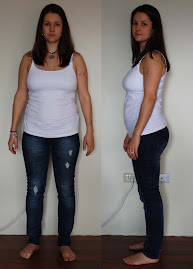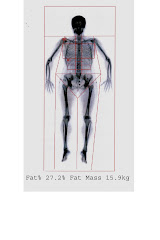Wednesday, September 21, 2011
Tuesday, September 20, 2011
September Mum of the Month - Meet Brenda
This month I am excited to introduce you to second time mum and our September Mum of the Month Brenda. Brenda first came to BBB sessions after the birth of her first daughter in 2009, she has now returned second time round and is getting fitter and looking more and more amazing every week!
Meet Brenda
How long have you been coming to Body Beyond Baby sessions?
Nearly 6 months this time round.
Was the childcare option a big decision maker in choosing BBB?
Yes!! i wanted to be able to have specific allocated times for exercise so that I could maintain consistency. I also like that Harper gets to socialise with other babies and spend time with someone other than myself. The nannies are fantastic.
Have you found it easier or harder getting back into shape after having your second baby?
I think I've been more focused this time around, only because my body changed ALOT after the second baby. I didn't think I would get my strength or fitness back because my second pregnancy was different and I didn't have as much time to excercise as I did with my first baby.
Can you share your ‘get back into shape’ secrets with us?
Consistency and training with intent and intensity. I make sure that I take an hour a day to myself to do excercise and have a rest one or two days a week. It's the only hour that I get to myself so I'm really selfish with it!!
Would you like to add anything else about your Body Beyond Baby experience?
It's a wonderful way to get back into excercise because you are guided through what are suitable excercises. Jen is a great trainer who pushes you and also tells you when you need to pull it back a bit. I like that you get to meet other mums and you can bounce ideas off them in regards to your children and other kiddy stuff. The environment is relaxed but focused and everyone is really supportive of each other. And we get to train outdoors!!
Meet Brenda
How long have you been coming to Body Beyond Baby sessions?
Nearly 6 months this time round.
Was the childcare option a big decision maker in choosing BBB?
Yes!! i wanted to be able to have specific allocated times for exercise so that I could maintain consistency. I also like that Harper gets to socialise with other babies and spend time with someone other than myself. The nannies are fantastic.
Have you found it easier or harder getting back into shape after having your second baby?
I think I've been more focused this time around, only because my body changed ALOT after the second baby. I didn't think I would get my strength or fitness back because my second pregnancy was different and I didn't have as much time to excercise as I did with my first baby.
Can you share your ‘get back into shape’ secrets with us?
Consistency and training with intent and intensity. I make sure that I take an hour a day to myself to do excercise and have a rest one or two days a week. It's the only hour that I get to myself so I'm really selfish with it!!
Would you like to add anything else about your Body Beyond Baby experience?
It's a wonderful way to get back into excercise because you are guided through what are suitable excercises. Jen is a great trainer who pushes you and also tells you when you need to pull it back a bit. I like that you get to meet other mums and you can bounce ideas off them in regards to your children and other kiddy stuff. The environment is relaxed but focused and everyone is really supportive of each other. And we get to train outdoors!!
As
a thank you and congratulations for being our Mum of the Month Brenda
receives a $50 voucher for nannying or babysitting services from Poppins Nanny Agency
Monday, September 12, 2011
So where DO burpees come from?
I was asked the other week who (in their right mind) invented burpees - one of my lovely clients, Emma, did a quick Google search and found this info from Wikipedia.... so for those of you losing sleep at night wondering where the burpee came from or even what a burpee even is here's your answer:
The burpee is a full body exercise used in strength training and as aerobic exercise. It is performed in five steps:
Less challenging
The burpee is a full body exercise used in strength training and as aerobic exercise. It is performed in five steps:
- Begin in a standing position.
- Drop into a squat position with your hands on the ground.
- Kick your feet back while lowering yourself with a pushup.
- Return your feet to the squat position while straightening your arms.
- Leap up as high as possible from the squat position with your arms overhead (you may clap your hands above your head at the peak of your jump)
Less challenging
- Non-jump burpee
- The athlete returns to the standing position without leaping off the ground.
- Knee push-up burpee
- The athlete bends their knees and rests them on the ground while performing the push up.
More challenging
- Long-jump burpee
- The athlete jumps forward, not upward.
- Tuck-jump burpee
- The athlete pulls their knees to their chest (tucks) at the peak of the jump.
- Jump-over burpee
- The athlete jumps over an obstacle between burpees.
- Box-jump burpee
- The athlete jumps onto a box, rather than straight up and down.
- One-armed burpee
- The athlete uses only one arm for the whole exercise including the pushup.
- Dumbbell burpee
- The athlete holds a pair of dumbbells while performing the exercise.
- Parkour burpee
- Following one burpee on the ground, the athlete jumps upon a table and performs the second burpee on the table, then jumps back to the initial position.
- Hindu push up burpee
- Instead of a regular push up, do a hindu push up.
- Pull-up burpee
- Combine a pull-up with the jump or do a pull-up instead of the jump.
- Muscle-up burpee
- Combine a muscle-up (a variation of a pull-up) with the jump or do a muscle-up instead of the jump.
- Double burpee
- Instead of one push up, do two in a row. This cancels the drive from landing after the jump and makes the next jump harder. Each part of the burpee might be repeated to make it even harder.
- One Leg burpee
- The athlete stands on one leg, bends at the waist and puts hands on ground so they are aligned with shoulders. Next jump back with the standing leg to plank position. Jump forward with the one leg that was extended, and do a one-leg jump. Repeat on opposite side.
- Side burpee
- The athlete bends at waist and places hand shoulder-width apart to
the side of right or left foot. Jump both legs out to side and land on
the outer and inner sides of your feet. Jump back in, jump up, and
repeat on opposite side.
Origin - According to the Oxford English Dictionary, the exercise was named in the 1930s for American psychologist Royal H. Burpee, who developed the Burpee test. Consisting of a series of the exercises performed in rapid succession, the test was meant to measure agility and coordination. It is not clear whether the exercise itself was invented by Burpee, or if his test merely popularized it.
Maybe we will be introducing a few of those variations into our sessions......and for those who previously missed in here's a great little video of my son, Marley performing his own burpee.
Thursday, September 8, 2011
Guest blog: 7 Tips for leaving your child at your BBB session (or anywhere else)
I believe one of the best bits of BBB is that we provide you with childcare for your little one - no scary big gym creches and no juggling grandparents or neighbours to ask them to look after your little one/s.
When you leave your child with our Body Beyond Baby nannies you can rest assured that they are being looked after by professional and experienced nannies who have been recruited by Poppins Nanny agency. Our nannies are professional and experienced. However we do know that every child is different and everyone's experience with leaving their child is different too.With this in mind I would like to introduce you to Jodi, founder and director of Poppins nanny agency and mother to three little girls (pictured). Here are her 7 tips to making the most out of your BBB session with our nannies:
1. Be conscientious about time
Try and Oorganise yourself in the morning so that you leave enough time to get to training with some spare time in case your baby needs feeding, changing or settling to sleep. If you’re not a morning person, try getting organised by packing bags and laying out clothes the night before so you’re not rushing in the morning. Rushing and being late will may make you stressed and this will carry through to your baby or toddler will pick up on this too..
2. Full tummy leads to a contented baby/toddler
If you’re breastfeeding, it is a good idea to give your baby a feed prior to the training session. (this will also help you to feel ‘less full’ and be more comfortable during your sessions).
For bottle-fed babies, ensure you bring a bottle with you, make sure our and let the nanniesy know where it is., make sure you put your name tags on your belongings and give the nannies any special instructions.
For toddlers, ensure they have eaten breakfast and pack some snacks and a drink. Keep snacks nut-free.
3. Don’t forget the ‘Creature Comforts’
Let ourthe BBB nanny know what makes your baby/toddler happy. It might be a favourite toy, blanket or action that makes your little one smile and feel comfortable and secure even when you’re not there. It’s also good for the nannies to know whether sitting or lying makes them feel comfortable – do they like tummy time or do they like to lie on their backs? (make sure you have filled out your child info sheet with this information, and write any really useful info on the white board)
If you’re child takes a dummy, don’t forget to bring along at least two as I find that dummies are like socks – they are good at disappearing acts.
If its sleep time for your baby or toddler then make sure you Bbring yourthe pram. The pram is a great and familiar place for your child to eat, sleep or just chill out.
4. A quick and painless exit
Keep your goodbyes short. Keep a smile on your face, even if your child is crying and reassure them that you will be back soon. Lingering to comfort your upset child can sometimes prolong their distress and even make it worse.
Resist the temptation to sneak away the second your child looks the other way as this can make children more upset once they realise you’ve gone, not getting a chance to say goodbye.
Nine times out of ten, your child will stop crying within five minutes of you leaving. Trust in the nanny’s experience and know they have your child’s best interest at heart and they will always call you if your child is distressed for an extended period of time. Make sure you write on the white board how long you would like our nannies to try to settle your child before calling you (they will override this and call you even earlier if necessary)
5. My child isn’t settling
Some children take a little longer than others to settle into new environments and new routines. Your child might settle happily the very first time or continue to be distressed beyond the first few weeks.
In all cases, it’s best to stay calm and remain positive. It is worth persevering for a little while to give your child time to adjust. It’s also important to communicate with the nannies and Jenny so you can work together to develop adjustment and settling strategies.
Keep in mind that throughout the session, if you’re child continues to be distressed, the nanny will come and get you to be with your child. You may have to build up to your child being left for a whole session. Perhaps start with 20 minutes, then 30, then 40 minutes, building up to the whole hour.
6. Label it or Lose it
Many children will have the same types of clothes, toys, bottles, etc so it is important to label everything with your child’s name so the nannies can make sure that you leave with the same belongings you came with.
7. Don’t forget the essentials – what to pack in the nappy bag- Sun hat
- Nappies
- Wipes
- nappy bags for dirty nappies
- bottles (for bottle-fed babies)
- dummy x 2
- food snacks and drink bottle (for toddlers)
- change of clothes
Have peace of mind while you train by following these tips and you can focus on staying fit and healthy.
Jodi is offering all BBB mums currently attending sessions a 25% discount off her agency fee for all casual and permanent bookings - to find out more visit the Poppins website here
When you leave your child with our Body Beyond Baby nannies you can rest assured that they are being looked after by professional and experienced nannies who have been recruited by Poppins Nanny agency. Our nannies are professional and experienced. However we do know that every child is different and everyone's experience with leaving their child is different too.With this in mind I would like to introduce you to Jodi, founder and director of Poppins nanny agency and mother to three little girls (pictured). Here are her 7 tips to making the most out of your BBB session with our nannies:
1. Be conscientious about time
Try and Oorganise yourself in the morning so that you leave enough time to get to training with some spare time in case your baby needs feeding, changing or settling to sleep. If you’re not a morning person, try getting organised by packing bags and laying out clothes the night before so you’re not rushing in the morning. Rushing and being late will may make you stressed and this will carry through to your baby or toddler will pick up on this too..
2. Full tummy leads to a contented baby/toddler
If you’re breastfeeding, it is a good idea to give your baby a feed prior to the training session. (this will also help you to feel ‘less full’ and be more comfortable during your sessions).
For bottle-fed babies, ensure you bring a bottle with you, make sure our and let the nanniesy know where it is., make sure you put your name tags on your belongings and give the nannies any special instructions.
For toddlers, ensure they have eaten breakfast and pack some snacks and a drink. Keep snacks nut-free.
3. Don’t forget the ‘Creature Comforts’
Let ourthe BBB nanny know what makes your baby/toddler happy. It might be a favourite toy, blanket or action that makes your little one smile and feel comfortable and secure even when you’re not there. It’s also good for the nannies to know whether sitting or lying makes them feel comfortable – do they like tummy time or do they like to lie on their backs? (make sure you have filled out your child info sheet with this information, and write any really useful info on the white board)
If you’re child takes a dummy, don’t forget to bring along at least two as I find that dummies are like socks – they are good at disappearing acts.
If its sleep time for your baby or toddler then make sure you Bbring yourthe pram. The pram is a great and familiar place for your child to eat, sleep or just chill out.
4. A quick and painless exit
Keep your goodbyes short. Keep a smile on your face, even if your child is crying and reassure them that you will be back soon. Lingering to comfort your upset child can sometimes prolong their distress and even make it worse.
Resist the temptation to sneak away the second your child looks the other way as this can make children more upset once they realise you’ve gone, not getting a chance to say goodbye.
Nine times out of ten, your child will stop crying within five minutes of you leaving. Trust in the nanny’s experience and know they have your child’s best interest at heart and they will always call you if your child is distressed for an extended period of time. Make sure you write on the white board how long you would like our nannies to try to settle your child before calling you (they will override this and call you even earlier if necessary)
5. My child isn’t settling
Some children take a little longer than others to settle into new environments and new routines. Your child might settle happily the very first time or continue to be distressed beyond the first few weeks.
In all cases, it’s best to stay calm and remain positive. It is worth persevering for a little while to give your child time to adjust. It’s also important to communicate with the nannies and Jenny so you can work together to develop adjustment and settling strategies.
Keep in mind that throughout the session, if you’re child continues to be distressed, the nanny will come and get you to be with your child. You may have to build up to your child being left for a whole session. Perhaps start with 20 minutes, then 30, then 40 minutes, building up to the whole hour.
6. Label it or Lose it
Many children will have the same types of clothes, toys, bottles, etc so it is important to label everything with your child’s name so the nannies can make sure that you leave with the same belongings you came with.
7. Don’t forget the essentials – what to pack in the nappy bag- Sun hat
- Nappies
- Wipes
- nappy bags for dirty nappies
- bottles (for bottle-fed babies)
- dummy x 2
- food snacks and drink bottle (for toddlers)
- change of clothes
Have peace of mind while you train by following these tips and you can focus on staying fit and healthy.
Jodi is offering all BBB mums currently attending sessions a 25% discount off her agency fee for all casual and permanent bookings - to find out more visit the Poppins website here
Friday, September 2, 2011
Client question: What sort of exercise can I do when pregnant??
I'm always excited to get emails with questions like this - Exercising when pregnant can be extremely beneficial to both mother and baby (in a 'normal', complication free pregnancy) Here's the question I received and my answer....
Q: What sort of exercise can one do when pregnant?? Or rather, what do I need to avoid? I'm only about six weeks so it's very early on. I've always had easy pregnancies but never really exercised and I didn't get back into decent exercise until after my second baby. I obviously don't want to stop but am assuming I need to take some sort
of care? What do you think?
A: The first thing to keep in mind when
exercising during pregnancy is that safety is key. In most cases if you
have been exercising prior to falling pregnant and have no
complications or contraindications then you may continue to exercise
during your pregnancy. Some alterations will need to be made to your resistance program especially as the pregnancy progresses.
A
non-exerciser who decides to take up resistance training during
pregnancy should be more cautious and take things slowly and steadily -
most preferably under the guidance of a trainer experienced in prenatal
exercise.
There are various benefits to exercising during pregnancy and these include:
- More comfort due to increased strength - in both everyday life and during delivery
- The ability to continue to perform day to day activities - as the pregnancy progresses and your body weight increases the muscular endurance and strength gained from resistance training helps make everyday tasks easier, including the lifting and carrying of growing toddlers
- Reduced back ache - from increased back strength and improved posture
- Easier post birth recovery - and return to resistance exercise along with a more positive self image
However, as we have already mentioned there are a few guidelines to follow:
- Training should be of low to moderate intensity - use your individual training history as a guide. If you have been training to a higher intensity previously your relative training intensity during pregnancy will be higher than that of a woman who didn't exercise previously. As a guide choose a weight which you can lift for 12-15 reps.
- Allow yourself an extended rest between sets - to allow your heart rate to recover. We used to focus on a maximum heart rate of 140bpm but these guidelines were removed in 1996 and the Perceived Rate of Exertion (PRE) scale more highly recommended. Your heart rate can vary quite significantly at different stages in your pregnancy so a heart rate monitor is not the best guideline. Knowing your body, being in tune with how you feel and adapting your workout accordingly is the best way to go.
- Holding your breath should be avoided at all times
- Stop doing all 'crunching', strong twisting or specific Rectus Abdominal exercises - as you may know from your first pregnancy the Rectus Abdominals may be forced to separate as your belly grows so stopping doing any specific strengthening exercises for this layer of tummy muscles can help to reduce the severity of any separation. Continuing to do your Transverse Abdominal exercise (Inner Core) is highly recommended.
- Train for maintenance rather than gain - as a rule of thumb on a PRE scale with 1 being 'sitting on the couch doing nothing' and ten being 'working as hard as you possible can' you should be sitting no higher than a 7/10.
- Be aware of decreased joint strength due to increasing levels of the hormone Relaxin - which can lead to a greater chance of strains and stresses. Be very careful if lifting weights above your head, choose lighter weights as a rule and be aware of increased mobility through the shoulder joints. The muscles around the hips and pelvis also become more relaxed in preparation for child birth so care should be taken when performing lunges - if you haven't done them before now is not the time to start and even seasoned gym goers should be aware of any pelvic or pubic pain. Leg strengthening exercises such as squats are more preferable at this time.
In short, resistance training during a normal
pregnancy carries more potential benefits than risks and doesn't even
require a gym membership to do it. Using resistance bands and tubing
are a great tool which can be used at home or in the park (whilst your
toddler is on the swings) and are very light and easy to carry - no
excuses!
Enjoy your resistance training throughout pregnancy and
the benefits it bring with it.
Subscribe to:
Posts (Atom)



































